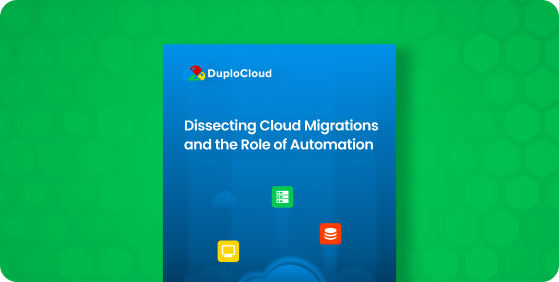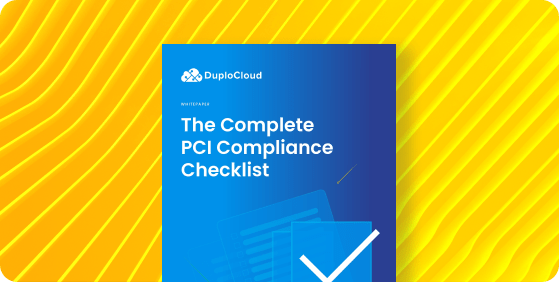Keep track of security development efforts across a dozen PCI compliance categories
With billions of credit card transactions occurring daily, the potential for fraud is higher than ever. In fact, the FTC reported over 65,000 cases of credit card fraud in 2021. If your product accepts credit card payments, it needs to be secure — which means it needs to be PCI compliant.
The PCI compliance process is complex, time-consuming, and full of moving parts. Attempting to achieve compliance without a plan can lead to complications like critical security flaws or failed compliance checks, which can negatively impact development timelines and your ability to generate revenue. Tracking your progress with a checklist can help you juggle multiple tasks and keep your team on the same page as it moves through the compliance process.
Jump to a section…
How to Achieve PCI Compliance (and Why You Need a Checklist)
Why You Should Make PCI Compliance a Priority
Download the DuploCloud PCI Compliance Checklist Today
What Is PCI Compliance?
In 2004, five major credit card companies joined forces to create the Payment Card Industry Security Standards Council (PCI SSC). They set out to develop payment processing security standards that retailers and product developers can follow to ensure cardholder information security in all credit card payment process components — from point-of-sale card reader devices to account information storage to data transfer.
The result of this alliance came in the form of the PCI Data Security Standard (PCI DSS). This document contains a series of requirements businesses must adhere to in order to process credit card payments with any of the companies associated with the PCI SSC. While achieving compliance with the PCI DSS is not a legal requirement, virtually all major credit card companies require compliance to accept payment.
How to Achieve PCI Compliance (and Why You Need a Checklist)
To achieve compliance, your product must adhere to the numerous requirements and stipulations in the PCI DSS documentation. The latest version of these security guidelines comes from PCI DSS 4.0, released in March 2022. This document has twelve categories covering the core standards that every product must adhere to safely and securely collect, transmit, and store sensitive cardholder information.
- Install and Maintain Network Security Controls: Controls must be in place to enforce predefined security policies and rules that monitor traffic between trusted and untrusted networks.
- Apply Secure Configurations to All System Components: Organizations must ensure all passwords and configurations are changed from default settings to provide a base level of security for network components.
- Protect Stored Account Data: Credit card numbers, addresses, and other identifiable data must be secured.
- Protect Cardholder Data With Strong Cryptography During Transmission Over Open, Public Networks: Because many customers will be making purchases from public, untrusted networks, data must be encrypted either before transmission, during, or both.
- Protect All Systems and Networks From Malicious Software: Organizations must be vigilant and protect network systems from malware like viruses, Trojans, and ransomware.
- Develop and Maintain Secure Systems and Software: Systems must be updated and patched regularly to prevent malicious actors from taking advantage of known exploits and vulnerabilities.
- Restrict Access to System Components and Cardholder Data by Business Need to Know: Authorized users should only have access to the systems and information they need, and nothing more.
- Identify Users and Authenticate Access to Systems Components: Users must be verified (through passwords, ID cards, or biometrics) before granting access.
- Restrict Physical Access to Cardholder Data: Organizations must also ensure that the physical locations and devices storing cardholder data are secured and properly disposed of when no longer needed.
- Log and Monitor All Access to System Components and Cardholder Data: Maintaining audit logs enables teams to monitor and track movement through network systems, helping to discover and flush out unauthorized access.
- Test Security of Systems and Networks Regularly: Review system capabilities and vulnerabilities regularly to ensure issues are discovered and addressed quickly.
- Support Information Security with Organizational Policies and Programs: Maintaining compliance is an ongoing process, and implementing and regularly reviewing policies ensures organization-wide compliance.
Within PCI DSS 4.0, each category contains multiple requirements, along with best practices and success and failure states, which guide organizations through each network component as they improve their overall security posture.
In addition to these requirements, organizations must be aware of four levels of PCI compliance, which will influence how they move through the compliance approval process. These levels determine the stringency of the audit. For example, national or international organizations that expect to process several million transactions yearly must achieve PCI Level 1 compliance, which requires filing a formal Report on Compliance from a certified third-party assessor. Meanwhile, small businesses that handle fewer than 20,000 annual transactions must only file a self-assessment questionnaire, which is filled out during an internal evaluation.
Because of the breadth of requirements and the sheer volume of moving parts in modern network infrastructure, keeping track of every step of the compliance process is crucial. Failure to achieve these requirements can mean the difference between a successful product launch and the inability to provide users with expected payment functionality. That’s why you need a checklist to help guide you through this process — download the free DuploCloud Complete PCI Compliance Checklist today.

Why You Should Make PCI Compliance a Priority
Achieving PCI compliance doesn’t just grant you access to credit card payment processes — it unlocks several core features that will improve the core functionality of your product. Benefits include:
- Upleveled security policies and standards: While securing sensitive cardholder data is the paramount goal of PCI compliance, the PCI DSS 4.0 provides instructions on developing sustainable processes that enhance all aspects of your organization’s approach to network security.
- Prevent data breaches: Achieving compliance helps create habits that enable your organization to monitor intrusion points and spot unauthorized access, stopping breaches before they occur.
- Save money: Without compliance, your organization may receive hefty fines, lose access to credit card payment privileges, or be subject to costly lawsuits — which will ultimately affect your bottom line.
- Build trust: PCI compliance carries a level of implicit trust from customers, clients, and vendors, letting them know you take data security seriously.
Download the DuploCloud PCI Compliance Checklist Today
Achieving PCI compliance is a critical step in any product’s development, and keeping tabs on every step of the process will help maximize your chances of success. That’s why we’ve crafted a checklist that helps guide organizations through the PCI DSS 4.0, keeping you on track through this complicated process. Inside, you’ll find a structured layout of each significant component of the PCI DSS requirements, along with crucial requirement highlights and links to necessary documentation. Download the free checklist today, and give your compliance efforts a head start.









